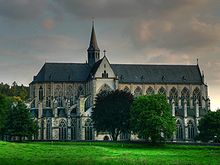Simultaneous church


Simultankirche , also Simultaneum or paritarian church , refers to a sacred building shared by several Christian denominations in denominational parity .
use
The services are generally held separately, a mixed service is only practiced in exceptional cases. Hospital chapels , for example, are often used in this way on a smaller scale .
The newly established simultaneous situations, in which a large part of the divine service is carried out together and are therefore called ecumenical, are different . An example of such a church is the Ecumenical Church Halden in St. Gallen. The modern form of the simultaneous church is an ecumenical center .

history
The first simultaneous church during and after the Reformation was probably the Church of St. Petri in Bautzen . The church house was already divided here in 1524, the nave, the sacristy and the organ gallery have been Protestant since then, the choir and the first gallery were used by the Roman Catholic believers.
In the territory of Count Palatine Christian August von Sulzbach in the northern Upper Palatinate , 49 simultaneous churches are documented from 1652 onwards. Simultaneum did not end until the beginning of the 20th century, and it still exists in nine churches today.
The Simultaneum was introduced by the authorities in the Electoral Palatinate on October 29, 1698 . The Reformed had to open their churches to Catholic worship, but the Catholics kept their churches alone. In total, the Catholics obtained the right to joint use of 240 churches. In many places around 1900, the larger denomination paid a sum of money to the smaller one so that it could build its own church or chapel. By decree of March 29, 1707, the Simultaneum in the Electoral Palatinate was repealed in the course of the Palatinate church division .
Simultaneous or parity churches were quite common in the Confederation, especially in Toggenburg , Glarus and in the subject areas jointly administered by Catholic and Reformed towns.
Simultaneous churches

The 64 simultaneous churches in Germany are spread across nine federal states or twelve regional churches or 18 dioceses . Most simultaneous churches are in Rhineland-Palatinate with 29 (corresponds to 45% of all simultaneous churches in Germany), followed by Bavaria with 19 churches (30%). Baden-Württemberg and Lower Saxony each have four simultaneous churches. In North Rhine-Westphalia , there are three in Hesse and Saxony-Anhalt two and one each in the Saarland and Saxony .
Other simultaneous churches:
- about 50 churches in Alsace
- several churches in the cantons of Thurgau (e.g. Basadingen , Ermatingen , Güttingen , Leutmerken , Pfyn , Sommeri , Uesslingen ) and St. Gallen (e.g. Mogelsberg , Oberhelfenschwil , Thal ) and a few in Graubünden ( Araschgen )
- Church of the Nativity in Bethlehem
- Church of the Holy Sepulcher in Jerusalem
Former simultaneous churches
In Switzerland, especially in the canton of Thurgau, numerous parity churches were dissolved in the course of the 20th century, either by one of the two parishes (mostly the Roman Catholic) building a new church for itself or by demolishing the old one and both of them a new building, e.g. B .:
- St. Margaret's Church in Gibstorf
- Church of St. Dionysius Willisdorf (1543–1967)
- City Church Glarus (previous building since the Reformation, current building 1866–1964)
- Parity church in Birmenstorf AG
Other former parity churches are located in Thurgau, for example in Aadorf , Berg , Diessenhofen , Hüttwilen , Mammern , Wängi , Weinfelden , and in the canton of St. Gallen in St. Peterzell and Nesslau-Krummenau .
Former simultaneous churches in Germany can be found here .
The Rechlin Church in Mecklenburg (built 1816–1832) was used simultaneously from 1934 to 1945 as the military church of the air force test site. The Catholic services were held until Bernhard Schwentner's arrest .
literature
- Heinz Henke: Housing communities under German church roofs. The simultaneous church conditions in Germany - an inventory. Self publication . Engelsdorfer Verlag, Leipzig 2008, ISBN 978-3-86703-932-1 .
- Timotheus Wilhelm Roehrich: The Simultaneum in the Alsatian churches . In: Timotheus Wilhelm Roehrich: Mittheilungen from the history of the Evangelical Church of Alsace . Volume 2: Evangelical images of the times, and the Church of the Fathers under the Cross . Treuttel and Würtz, Strasbourg et al. 1855, pp. 231-250, online .
- Christoph Schäfer: The Simultaneum. A state church law, political and theological problem of the Old Kingdom. P. Lang et al. 1995, ISBN 3-631-49090-9 ( European university publications . Series 2: Jurisprudence 1787), (Simultaneously: Freiburg (Breisgau), Univ., Diss., 1995).
- Ute Verstegen: Multi-religious prayer rooms - historical scenarios of a current phenomenon . In: INSITU. Zeitschrift für Architekturgeschichte 6 (1/2014), pp. 5–18 (16ff).
- Bernard Vogler: Simultaneum . In: Theological Real Encyclopedia . Vol. 31 (2000), pp. 280-283 (with a list of older literature).
Web links
Individual evidence
- ↑ Experience. Experienced. Discover. How moved the Church! Information flyer from the Förderverein Simultankirchen id Oberpfalz eV, April 9, 2015, accessed on March 18, 2017 (pdf, 2.9 MB).
- ↑ Heinz Henke: Residential communities under German church roofs: The simultaneous church conditions in Germany - an inventory . Self publication . Engelsdorfer Verlag, 2008 ( publisher's report ).
- ^ Simultaneous churches in the Palatinate